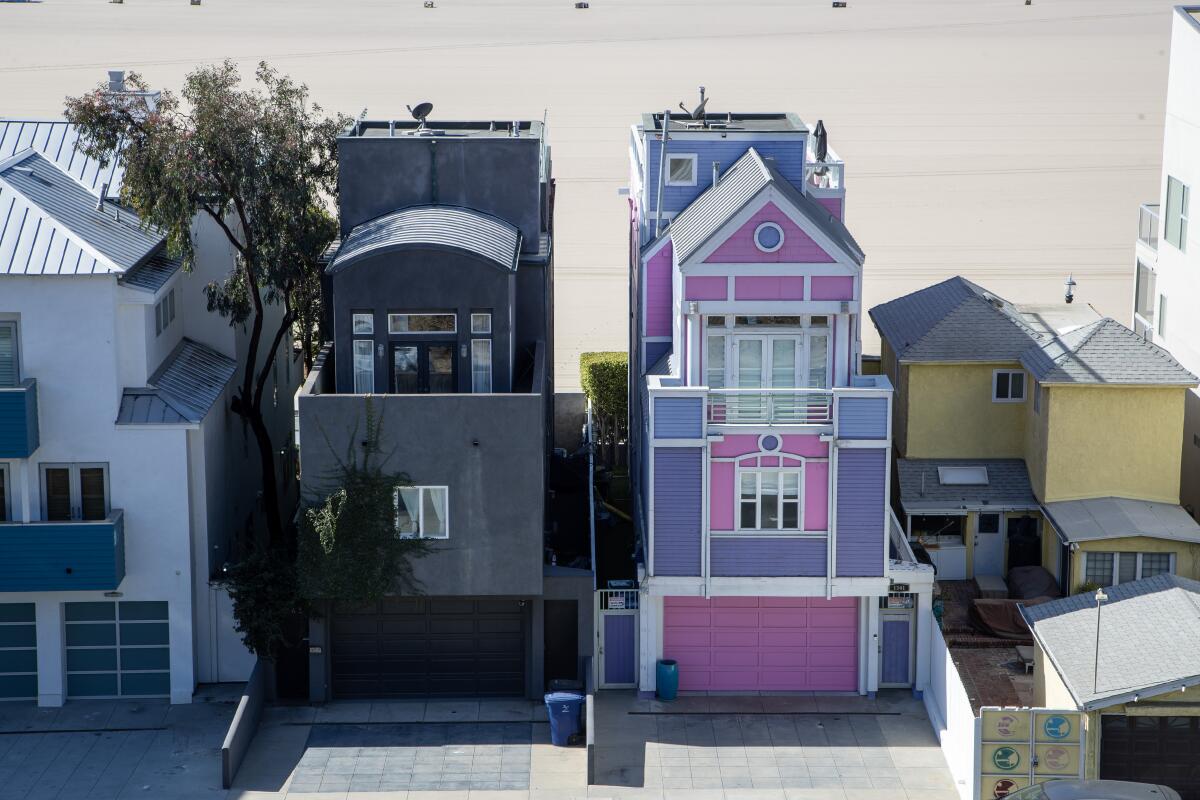Looking back at Dianne Feinstein’s storied California career
Good morning, and welcome to the Essential California newsletter. It’s Friday, Feb. 17. I’m Jessica Garrison, the Northern California correspondent at The Times.
The big political news in the state this week is the announcement from Sen. Dianne Feinstein — California’s longest serving senator — that she would finish out her term but would not seek reelection.
The move sets the state for what is expected to be an expensive and bitter fight to replace the Democrat in 2024.
It has also prompted a flood of reflections about Feinstein’s remarkable career, which began in 1969, when she was elected to the San Francisco Board of Supervisors. She was the first woman elected to the board without having first been appointed.
“You can’t tell the story of California politics — or the story of American politics — without the trailblazing career of Dianne Feinstein,” Sen. Alex Padilla (D-Calif.) said.
Almost a decade after her election, Feinstein became the first woman to serve as San Francisco’s mayor. She assumed the role after the 1978 murders of Mayor George Mascone and Supervisor Harvey Milk.
In 1992 came another first: she became California’s first female senator after she won a special election to replace Sen. Pete Wilson, who resigned to serve as governor of California. Voters also elected Barbara Boxer to the Senate in the “year of the woman,” though Feinstein was sworn in first.
The Times Op-Ed columnist Nick Goldberg recalled his annual visits to Feinstein’s office when he was editorial page editor, well into Feinstein’s tenure in the Senate.
“She’d offer me a glass of wine, even though it was generally 3 or 4 in the afternoon. She always seemed both surprised and a little disappointed when I said no,” he wrote.
He remembered that she often had a little lap dog with her, lending the whole affair the feeling of a visit to grandma’s house — “but only if your grandmother was also an expert on arcane matters of California water policy and deeply steeped in the gory details of CIA torture.”
Also, he recalled, she often had some really fun gossip. Sadly, it was off the record and journalistic ethics prevented Goldberg from sharing it. (Maybe if he had accepted that wine…)
Feinstein, Goldberg noted, came of age in a more genteel political era, where “Democrats and Republicans could fight all day and have dinner together at night” and in recent years, he noted, she had reportedly begun to suffer cognitive decline and struggle with the demands of her job.
Her recent years have been marked by speculation about her condition and pressure from those in her own party to step down. Feinstein resisted.
Times columnist George Skelton wrote that he asked the Senator about her mental state in December 2020.
“I don’t feel my cognitive abilities have diminished,” she answered. “No, not really. Do I forget something sometimes? Quite possibly.”
But in his recollection about the senator, Skelton praised her for her courage and determination in her long history of service. Her accomplishments included gun control legislation, a report holding the CIA to account for its treatment of detainees and countless pieces of legislation to benefit the environment and fight climate change.
“She is one of the most meaningful and accomplished lawmakers Californians ever put in office,” wrote Times columnist Mark Barabak in his own remembrance.
“It is not just her legislative achievements, in areas like environmental protection and gun control, that distinguish Feinstein’s more than half-century-long public career,” he noted.
“Just as significant, if not more, is the path she helped blaze for women in politics, first by seeking and winning elected office and then, once empowered, by showing that a woman could more than hold her own among the far greater number of men jostling around her.”
And now, here’s what’s happening across California:
Note: Some of the sites we link to may limit the number of stories you can access without subscribing.
L.A. STORIES
Culver City’s transformation from “the heart of screenland” to the “heart of streamland” has lead to tension. The Times’ Wendy Lee goes deep into the conflicts arising as streaming studios including Amazon, HBO, and TikTok transform the small city on the West side of Los Angeles County. “I’m going to be priced out,” one resident told Lee. “I love it here and I understand the growth, but don’t forget about the people who sustained Culver City before the big industry with money coming in.” Los Angeles Times

The real story of Barbie House and Batman’s Bachelor Pad. For everyone who has wondered about the side-by-side houses on Santa Monica Beach — one pink, one black, and both stars of Instragram — The Times’ Jack Flemming has the scoop. Contrary to conventional wisdom, the Barbie House was not built for Ruth Handler, who invented the Barbie doll in 1959. She lived farther up PCH in Malibu. Los Angeles Times
Check out "The Times" podcast for essential news and more
These days, waking up to current events can be, well, daunting. If you’re seeking a more balanced news diet, “The Times” podcast is for you. Gustavo Arellano, along with a diverse set of reporters from the award-winning L.A. Times newsroom, delivers the most interesting stories from the Los Angeles Times every Monday, Wednesday and Friday. Listen and subscribe wherever you get your podcasts.
POLITICS AND GOVERNMENT
The L.A. City Council fights about redistricting again. Months after a leaked racist tape on the topic threw Los Angeles politics into crisis, the City Council took up the issue of redistricting again this week. At Wednesday’s meeting, the council considered whether reform should be driven by the state Legislature or through a parallel local effort already in the works. The council ultimately voted 11 to 2 to formally oppose the state bill. Los Angeles Times
CRIME, COURTS AND POLICING
The Oakland Police Department has a long history of trouble and scandal. This week Mayor Sheng Thao fired the city’s latest police chief, LeRonne Armstrong, after an investigation found he mishandled two officer misconduct cases. After that development, the San Francisco Chronicle published a look back at more than two decades of strife in the department, starting with the infamous Riders case, in which four officers were arrested on felony charges. Three were later acquitted, but the city ended up paying nearly $11 million to 119 people who said they had been wrongly arrested. The police department wound up under federal oversight, where it remains. San Francisco Chronicle
Police dogs could be banned from certain jobs in California. Two state lawmakers have introduced a bill that would ban the use of police canines for arrests, apprehensions and crowd control, saying officers have long targeted and brutalized Americans of color with police dogs. Assemblymembers Corey Jackson (D-Perris) and Ash Kalra (D-San Jose) introduced AB 742 to “end a deeply racialized and harmful practice,” according to a news release. Los Angeles Times
Support our journalism
HEALTH AND THE ENVIRONMENT
Health inequities continue to hit Black Californians. More than half of Black Californians said there was a time in the last few years when they thought they would have received better healthcare if they had belonged to a different racial or ethnic group, according to a report released Thursday. The results come as lawmakers, health providers and public health agencies grapple with how to explain and curb longtime racial health inequities. Los Angeles Times
CALIFORNIA CULTURE
Happy Birthday to the Hollywood Sign, which turns 100 this year. The inimitable Patt Morrison gives us the history of the sign — from real estate marketing gimmick to beloved cultural landmark — and other famous Los Angeles structures born in 1923. Come for the Hollywood sign, stay for the Black Dahlia reference in the Biltmore Hotel. Los Angeles Times
Free online games
Get our free daily crossword puzzle, sudoku, word search and arcade games in our new game center at latimes.com/games.
AND FINALLY
Today’s California landmark is from Marjorie Weingrow of Point Richmond, Calif., who wants to highlight the parks of Richmond, Calif., northwest of San Francisco.

Marjorie writes:
People think of Richmond, Calif. as a city laden with crime and problems. However, there are lovely parks right on the Bay. My favorite is Miller Knox Park with sweeping views of S.F., Oakland and Mt. Tam.
What are California’s essential landmarks? Fill out this form to send us your photos of a special spot in California — natural or human-made. Tell us why it’s interesting and what makes it a symbol of life in the Golden State. Please be sure to include only photos taken directly by you. Your submission could be featured in a future edition of the newsletter.
Please let us know what we can do to make this newsletter more useful to you. Send comments to [email protected].
Sign up for Essential California
The most important California stories and recommendations in your inbox every morning.
You may occasionally receive promotional content from the Los Angeles Times.




